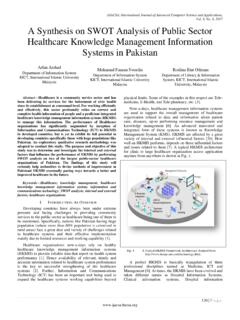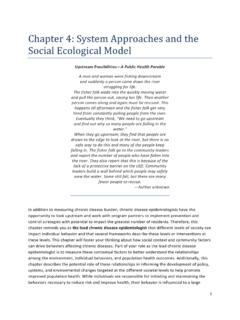Transcription of Understanding China's Political System
1 CRS Report for CongressPrepared for Members and Committees of Congress Understanding China s Political System Susan V. Lawrence Specialist in Asian Affairs Michael F. Martin Specialist in Asian Affairs May 10, 2012 Congressional Research Service 7-5700 R41007 Understanding China s Political System Congressional Research Service Summary This report is designed to provide Congress with a perspective on the contemporary Political System of China, the only Communist Party-led authoritarian state in the G-20 grouping of major economies. China s Communist Party dominates state and society in China, is committed to maintaining a permanent monopoly on power, and is intolerant of those who question its right to rule.
2 Nonetheless, analysts consider China s Political System to be neither monolithic nor rigidly hierarchical. Jockeying among leaders and institutions representing different sets of interests is common at every level of the System . A test of the Political System will come later this year, when the Communist Party plans to usher in a new set of top leaders at its 18th Congress. China s last two major Political transitions, in 1997 and 2002, unfolded relatively smoothly. This year, the Political System has been shaken by the recent ouster of a senior Party leader, Bo Xilai. The unity of the remaining leadership remains unclear.
3 The report opens with a brief overview of China s leading Political institutions. They include the Communist Party and its military, the People s Liberation Army; the State, led by the State Council, to which the Party delegates day-to-day administration of the country; and the National People s Congress (NPC), China s unicameral legislature. The NPC is meant to oversee the State Presidency, the State Council, the Supreme People s Court, the Supreme People s Procuratorate (China s public prosecutor s office), and the military. In practice, the legislature is controlled by the Communist Party and is able to exercise little oversight over any of those institutions.
4 Following the overview, the report introduces a number of distinct features of China s formal Political culture and discusses some of their implications for relations. Those features include the fact that China is led not by one leader, but by a committee of nine; that provincial leaders are powerful players in the System ; that the System treats statements by individual leaders as less authoritative than documents approved by committee; and that ideology continues to matter in China, with the Communist Party facing vocal criticism from its left flank each time it moves further away from its Marxist roots.
5 Other themes include the importance of meritocracy as a form of legitimization for one-party rule, and ways in which meritocracy is being undermined; the introduction of an element of predictability into elite Chinese politics through the enforcement of term and age limits for holders of public office; the Chinese System s penchant for long-term planning; and the System s heavy emphasis on maintaining Political stability. The next section of the report discusses governance challenges in the Chinese Political System , from stove-piping and bureaucratic competition, to the distorting influence of bureaucratic rank, to factionalism, corruption, and weak rule of law, as highlighted by the case of the blind legal advocate Chen Guangcheng.
6 A text box discusses the case of the disgraced senior leader Bo Xilai. The second half of the report is devoted to detailed discussion of China s formal Political structures the Party, the military, the State, the National People s Congress, a consultative body known as the China People s Political Consultative Conference, and China s eight minor Political parties, all of which are loyal to the Communist Party. Also discussed are other Political actors who are playing a role in influencing policy debates, including the media, big business, research institutes, university academics, associations, societies, and grassroots non-governmental organizations.
7 The report concludes with a discussion of prospects for Political reform, noting that while China s Premier Wen Jiabao has called for undefined Political reform, Party policy is to reject vigorously the notion of a multi-party System , separation of powers, a bicameral legislature, or a federal System , on the grounds that all are unsuited to China s conditions. Understanding China s Political System Congressional Research Service Contents 1 Overview of China s Political Institutions .. 2 Features of China s Formal Political Collective Leadership .. 3 The Power of Provincial Governments .. 4 Document-Based Culture.
8 6 The Importance of Ideology ..7 The Ideal of Meritocracy .. 8 Age and Term Limits for Official Positions .. 8 Emphasis on Long-Term Planning .. 9 Emphasis on Political 9 Governance Challenges in the Chinese Political System .. 10 Stove-Piping and Bureaucratic 10 The Distorting Influence of Bureaucratic Rank .. 11 Weak Rule of Law and Ineffective Policy Implementation and Enforcement .. 14 Factionalism .. 15 15 China s Political Institutions in Detail .. 16 The Chinese Communist Party (CCP).. 16 The People s Liberation Army (PLA) .. 19 The State .. 21 The National People s Congress (NPC).. 24 The Chinese People s Political Consultative Conference (CPPCC).
9 25 The Minor Political 25 Other Political 26 Traditional Media, New Media, and a Wired Citizenry .. 26 Big Business .. 27 Official and Quasi-Official Research 29 University 30 Officially-Sponsored Associations and Societies .. 30 Grassroots 31 Chinese Authorities View of Political 31 Figures Figure 1. China s National-Level Communist Party 4 Figure 2. Map of 6 Figure 3. Organization Chart for the People s Liberation 21 Ta b l e s Table 1. Select Chinese Institutions and Their Bureaucratic Ranks .. 13 Understanding China s Political System Congressional Research Service Contacts Author Contact 33 Acknowledgments.
10 33 Understanding China s Political System Congressional Research Service 1 Introduction This report is designed to provide Congress with a perspective on the contemporary Political System of China, the world s second largest economic power, one of five permanent members of the United Nations Security Council, and the only Communist Party-led authoritarian state in the G-20 grouping of major By introducing some of the distinct features and governance challenges of China s Political culture, the report aims to help Congress understand the ways in which Political actors in China interact, or in some cases, fail to interact, with implications for China s relationship with its neighbors and the world.









